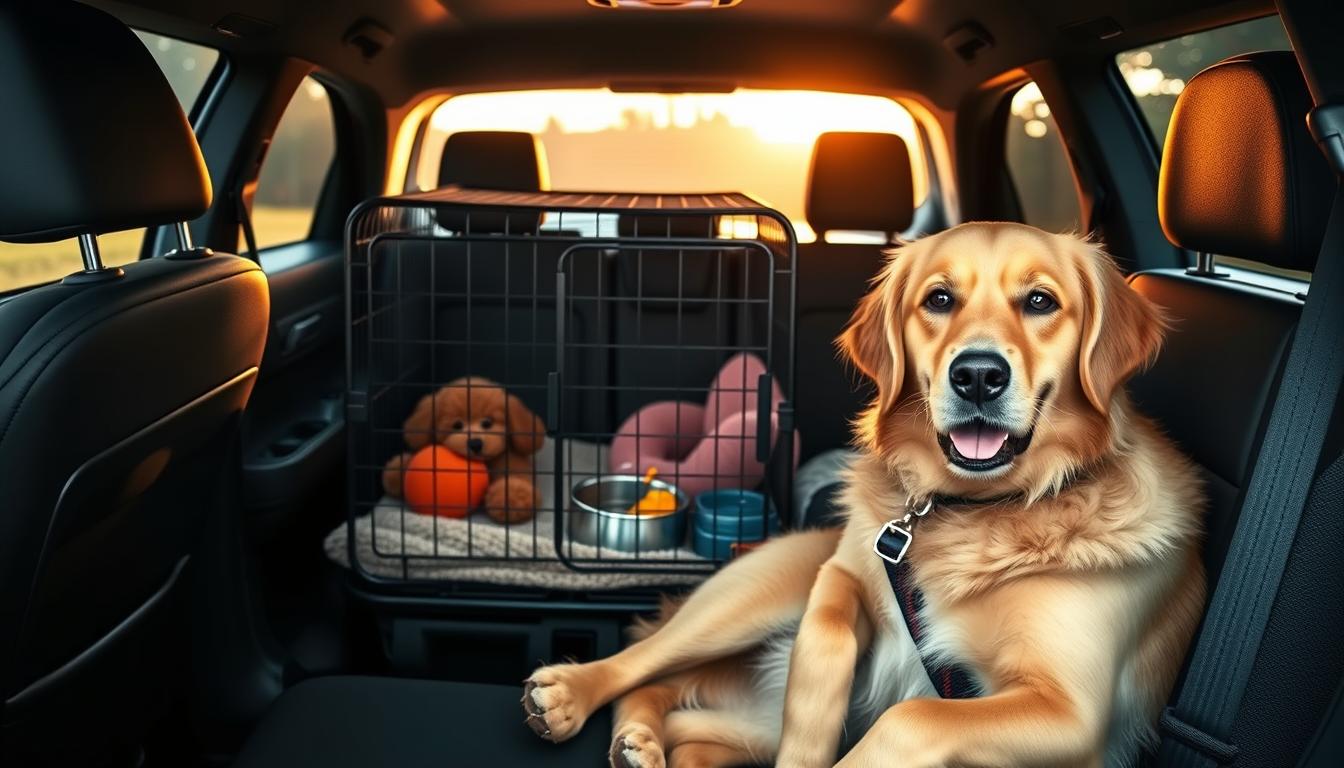Traveling with dogs can be a fun experience. But, it needs careful planning to keep them safe and comfortable, mainly in hot weather. Dog car travel safety is very important for pet owners who enjoy road trips with their furry friends.
As the temperature goes up, it’s key to prevent overheating and make sure your dog is comfortable. In this article, we’ll share important tips and strategies for keeping your dog cool and safe in the car.
Key Takeaways
- Plan your trip according to the weather
- Never leave your dog unattended in a hot car
- Use sunshades or window visors to block direct sunlight
- Provide adequate ventilation and cooling
- Take regular breaks for exercise and hydration
Understanding the Risks of Heat for Dogs in Cars
Dogs face dangers when in cars in hot weather. It’s crucial to understand these risks. Even with windows open, a car can become deadly for dogs in heat.
Why Dogs Are More Vulnerable to Heat Than Humans
Dogs cool down by panting, which is less effective than human sweat. This makes them more likely to get heatstroke in hot cars.
The Science Behind Car Temperature Elevation
A car in sunlight can get very hot inside. Studies show a car can hit 120°F in 30 minutes when it’s 80°F outside.
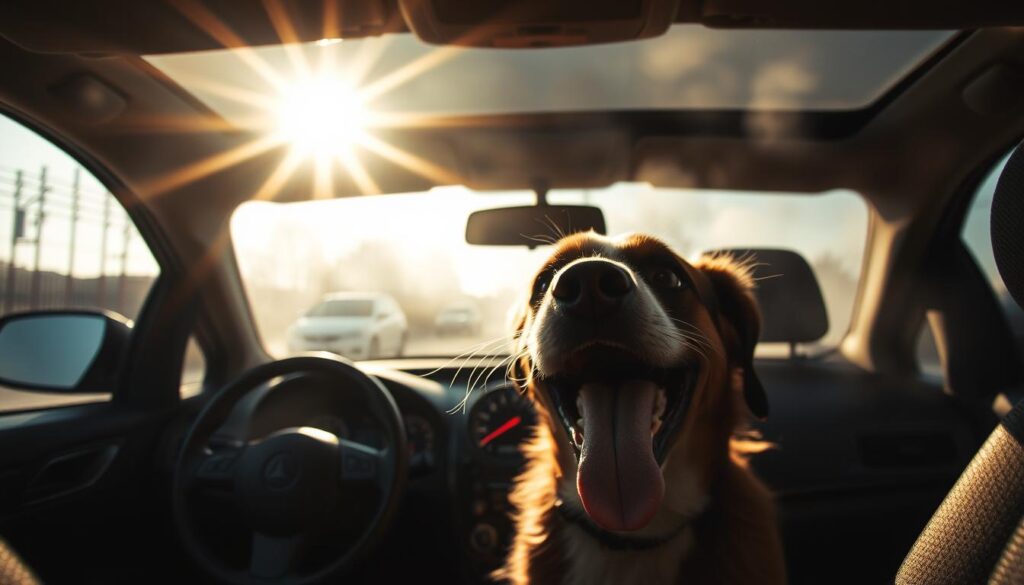
The Dangers of Leaving Dogs in Hot Cars
Leaving dogs in hot cars can cause heatstroke, a serious condition. The table below shows how temperature and time affect a dog’s risk of heatstroke.
| Outside Temperature (°F) | Time to Reach 100°F Inside Car | Risk Level |
|---|---|---|
| 70 | 4 minutes | Low |
| 85 | 2 minutes | Moderate |
| 100 | 1 minute | High |
| 115 | 30 seconds | Extremely High |
Never leave your dog unattended in a car during warm weather. The risks are too great, and the consequences can be fatal.
Pre-Travel Preparation for a Cool Journey
A successful road trip with your dog starts with thorough pre-travel preparations. This keeps them cool and safe. Ensuring your dog’s comfort and safety during car travel involves several key steps.
Scheduling Travel During Cooler Hours
One of the most effective ways to keep your dog cool during travel is to schedule your trip during the cooler parts of the day. This means early morning or late evening. It reduces the risk of your dog being exposed to high temperatures.
Acclimating Your Dog to Car Travel
Before embarking on a long journey, it’s essential to acclimate your dog to car travel. Start with short drives and gradually increase the duration. This helps your dog become comfortable with the motion of the car and the confinement.
Pre-Travel Veterinary Checkups
A pre-travel veterinary checkup is crucial to ensure your dog is healthy enough for travel. Your vet can provide advice tailored to your dog’s specific needs and health status.
Creating a Travel Checklist for Hot Weather
Creating a travel checklist can help ensure you don’t forget essential items for your dog’s comfort and safety. Here’s a simple table to get you started:
| Item | Purpose |
|---|---|
| Water and portable bowl | Hydration on the go |
| Cooling mat or vest | Keeping your dog cool |
| Sunshades or window screens | Reducing direct sun exposure |
| First-aid kit | For emergencies |
By following these pre-travel preparations, you can significantly enhance your dog’s travel experience. This ensures a cool and enjoyable journey for both you and your canine companion.
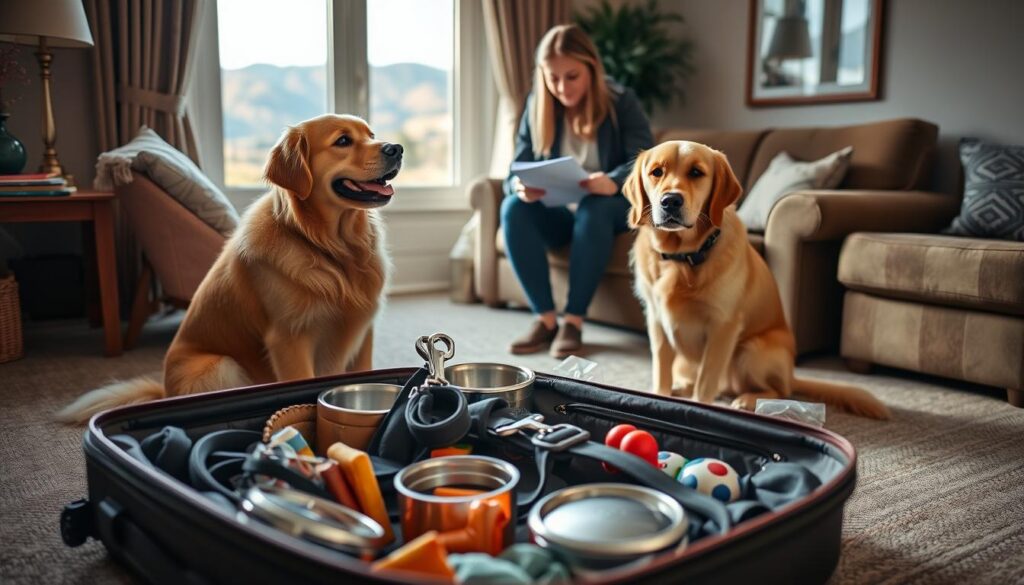
Essential Gear for How to Keep Dogs Cool in the Car While Traveling
As temperatures rise, dog owners need the right gear to keep their pets cool in the car. The right equipment is key for a comfortable journey.
Cooling Mats and Vests
Cooling mats and vests help dogs stay cool by removing heat from their bodies. The Arctic Ice Dog Cooling Vest is a favorite among dog owners. It uses a cooling gel that gets cold when exposed to air.
Portable Water Bowls and Bottles
It’s important for dogs to stay hydrated while traveling. The Outward Hound Hydrant Dog Water Bottle is a great choice. It’s spill-proof and easy to use on the go.

Sunshades and Window Screens
Sunshades and window screens block direct sunlight, keeping the car cooler. The HeatShield Sun Shade fits different car windows. It provides shade and reduces heat.
Travel-Friendly Cooling Toys
Cooling toys keep dogs mentally stimulated and cool. Toys filled with gel or water that can be frozen are great. They keep your dog busy and cool.
Battery-Operated Fans for Dogs
Battery-operated fans are a good way to keep dogs cool in the car. The Pawfect Pets Cooling Fan directs airflow towards your dog. It makes the journey more comfortable.
“The right gear makes a big difference in your dog’s comfort in the car,” says dog travel expert, Jane Smith. “Cooling mats, portable water bowls, and sunshades ensure a safe and fun trip for your pet.”
Vehicle Preparation for Dog-Friendly Travel
Getting your car ready for dog-friendly travel is key for a fun and safe trip. A well-prepared car makes your dog more comfortable. It also makes the trip less stressful for both of you.
Optimal Air Conditioning Settings
One important thing is to make sure the air conditioning works well. Set the temperature to a comfy level before your dog gets in. Also, make sure the air vents are clear for good airflow in the car.
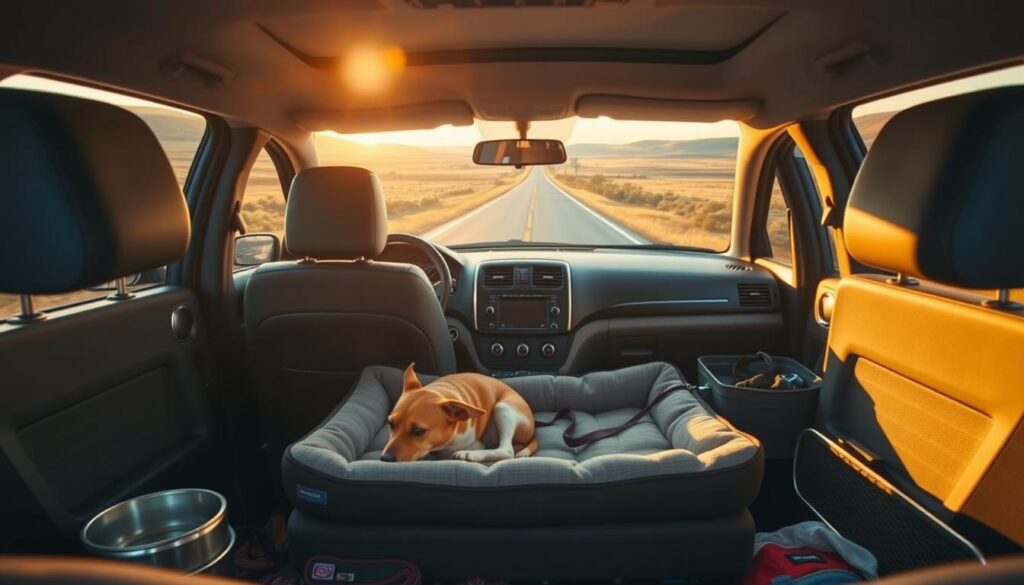
Creating Shade in Your Vehicle
Dogs can get too hot in the sun. To keep them cool, use sunshades or window screens for shade. This helps keep the car cooler and protects your dog from UV rays.
Safe Restraint Systems That Allow Airflow
It’s important to use a safe way to keep your dog in the car. Choose harnesses or carriers that let air flow around your dog. This keeps them safe and cool.
Pre-Cooling Your Car Before Travel
Pre-cooling your car before you leave can really help. Start the car and turn on the AC a few minutes before you go. This cools the car down, helping your dog stay cool too.
By following these tips, you can make your dog’s travel experience better. A bit of preparation can make your journey together a success.
Hydration Strategies for Traveling Dogs
Keeping your dog hydrated is key for their health and comfort. Dehydration can cause serious health problems, like heat stress. It’s important to make sure your dog has enough water and to encourage them to drink.
How Much Water Your Dog Needs During Travel
The water needs of your dog depend on their size, age, and the temperature. Dogs usually need about 1 ounce of water per pound of body weight each day. When traveling, you might need to give them a bit more water to help with the stress and changing temperatures.
Creative Ways to Encourage Drinking
It can be hard to get your dog to drink enough water, but there are ways. Use a portable water bowl and offer water often. You can also make water more tempting by adding a little low-sodium chicken broth. Or, try a dog water fountain, which moves water to make drinking more fun.
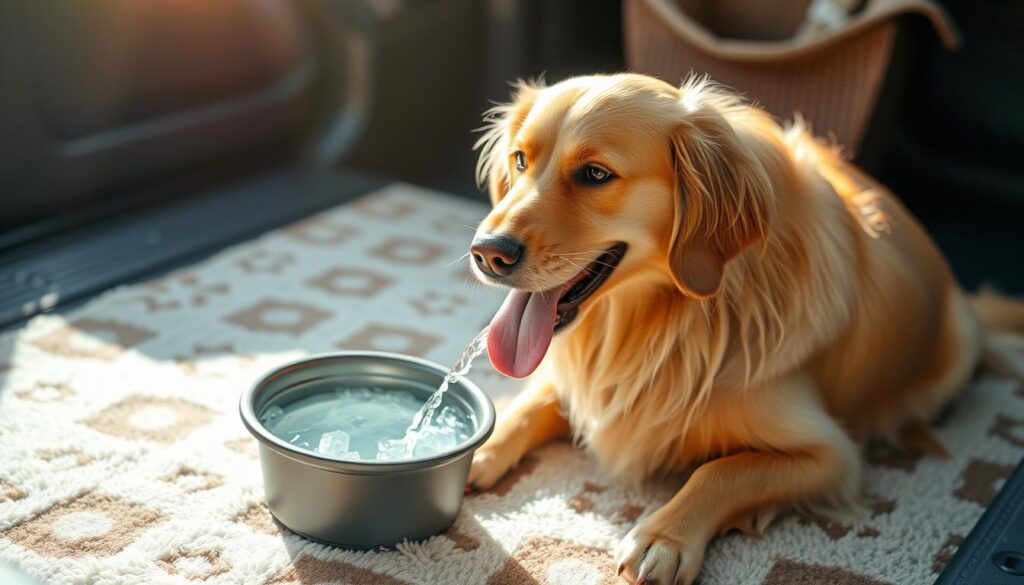
Avoiding Dehydration on Long Trips
On long trips, keep a close eye on your dog’s water intake. Make sure to stop at places where dogs can drink and stretch. You can also give them ice cubes made from low-sodium broth or water to stay hydrated and cool.
Frozen Treats for Hydration and Cooling
Frozen treats can help keep your dog hydrated and cool. You can make them at home with safe ingredients like peanut butter, pumpkin, and chicken broth. These treats are not only fun but also help keep your dog hydrated and cool during travel.
| Hydration Tip | Description | Benefit |
|---|---|---|
| Portable Water Bowl | Easy to carry and use during stops | Encourages drinking on the go |
| Frozen Treats | Made with dog-safe ingredients | Provides hydration and cooling |
| Low-Sodium Broth | Added to water or used in treats | Makes water more appealing |
Recognizing Signs of Overheating in Dogs
Overheating can be deadly for dogs. Knowing the signs can save their lives. When traveling, watch your dog closely. The risk of overheating goes up, mainly in cars.
Early Warning Signs to Watch For
Spotting early signs of overheating is key to avoiding serious problems. Look out for:
- Excessive panting
- Drooling
- Restlessness
- Bright red gums
These signs mean your dog is stressed from the heat. Quick action can help a lot.
Serious Symptoms Requiring Immediate Action
If your dog shows any of these symptoms, get vet help fast:
- Collapse
- Seizures
- Rapid heartbeat
- Fever
Quick vet care is vital to avoid death.
Breed-Specific Heat Sensitivity Concerns
Some dog breeds face more heat-related problems because of their looks.
Brachycephalic Breeds (Bulldogs, Pugs, etc.)
Brachycephalic breeds can’t cool down well because of their short noses. Be extra careful when traveling with them.
Double-Coated Breeds (Huskies, Malamutes, etc.)
Double-coated breeds get hot because their thick fur traps heat. Keep them cool and groom them often.
Senior Dogs and Puppies
Older dogs and puppies can’t handle heat well. Keep a close eye on them when traveling.
Emergency Cooling Techniques for Overheated Dogs
Emergency cooling techniques are key to saving dogs from heat-related illnesses during travel. When dogs get too hot, their condition can worsen fast. So, acting quickly is vital.
Immediate Steps to Take
If your dog shows signs of overheating, like panting a lot, drooling, or acting restless, act fast. Move your dog to a cooler area right away. Use a wet towel or cloth to cool them down.
You can also mist your dog with water from a spray bottle. Focus on the neck and armpits, where blood vessels are closer to the surface.
When to Seek Veterinary Help
If your dog’s temperature goes over 104°F (40°C), or if they show severe heat stroke signs, seek veterinary help immediately. Waiting too long can cause serious problems or even death.
Creating an Emergency Cooling Kit
Being prepared is important. Make an emergency cooling kit with a cooling pad, cold packs, a spray bottle, and a bowl. Having these items ready can help cool your dog down fast in an emergency.
First Aid for Heat Stroke
For dogs with heat stroke, it’s crucial to lower their body temperature safely. Use cool (not cold) water to avoid shock. Monitor their temperature closely and adjust your cooling efforts as needed.
If you’re unsure about your dog’s condition, always play it safe and talk to a vet.
Planning Strategic Stops for Cooling Breaks
Keeping your dog cool during car travel is more than just the drive. It’s also about the stops you make. Strategic stops can make a big difference in your dog’s comfort and safety on long trips.
Finding Dog-Friendly Rest Areas
Finding dog-friendly rest areas is key for successful cooling breaks. Many places welcome dogs, but it’s important to check first. Websites and apps for pet-friendly travel can help you find the right stops.
Activities to Help Dogs Cool Down During Stops
At these breaks, activities that help your dog cool down are great. Short walks, playtime with water, and cool treats can help lower their temperature. Make sure the area is safe and right for these activities.
Ideal Stop Frequency and Duration
The right stop frequency and duration depend on your dog’s age, breed, and health. Stopping every few hours for 15-20 minutes lets your dog rest and cool down. Monitoring your dog’s behavior and adjusting the stops is important.
Safe Places to Exercise During Breaks
When exercising your dog, choose a safe and shaded area. Avoid the hottest sun hours and pick grass or dirt over hot asphalt. Make sure your dog has fresh water during exercise.
“The journey of a thousand miles begins with a single step, and for our canine friends, it begins with a cool and comfortable stop.”
By using these strategies, you can make your dog’s travel more enjoyable and safe.
Legal Considerations for Dogs in Cars
When you’re planning a trip with your dog, learn about the laws regarding dogs in cars. This will help make your journey safe and legal.
State Laws Regarding Dogs in Vehicles
Each state has its own rules for dogs in cars. Some laws say dogs can’t be left alone in cars. Others have broader laws against animal cruelty. Some states even require dogs to be buckled up while driving.
Good Samaritan Laws for Rescuing Dogs
Good Samaritan laws help people who save dogs from hot cars. These laws vary but usually protect those who act to save animals in good faith.
Legal Consequences of Leaving Dogs in Hot Cars
Leaving dogs in hot cars can lead to serious legal trouble. You could face fines or animal cruelty charges. It’s important to know the risks and legal outcomes of such actions.
Travel Documentation Requirements
Traveling with dogs, across state lines, requires the right travel documentation. You’ll need health certificates and vaccination records. Make sure you meet all requirements to avoid legal problems on your trip.
Special Considerations for Different Travel Scenarios
Different travel scenarios present unique challenges when traveling with dogs. It’s important to tailor your approach for a successful trip. Understanding these differences is crucial for ensuring your dog’s comfort and safety.
Long-Distance Road Trips vs. Short Journeys
Long-distance road trips need more planning. You’ll need to make regular stops for exercise and hydration. Short journeys, on the other hand, require immediate attention to comfort and safety. This includes proper restraint and ventilation.
Traveling in Different Vehicle Types
The type of vehicle can greatly impact your dog’s travel experience.
-
SUVs and Minivans
- These vehicles offer ample space for dogs to move around comfortably. They are ideal for long trips.
-
Sedans and Compact Cars
- Space is limited in these vehicles. You’ll need to plan carefully to ensure your dog’s comfort.
-
Trucks with Open Beds
- While exciting for dogs, open beds require special safety measures. Secure tethering is essential.
Traveling with Multiple Dogs
Traveling with multiple dogs complicates logistics. You’ll need more space, supplies, and attention to individual needs. Ensuring each dog has its own space and resources can help reduce stress.
Seasonal Adjustments for Travel
Seasonal changes demand adjustments in travel planning. For instance, summer travel requires extra measures for cooling and hydration. Winter travel necessitates warmth and protection from cold surfaces.
“Preparation is key to a successful trip with your dog.” By considering the unique demands of different travel scenarios, you can ensure a safe and enjoyable journey for both you and your canine companion.
Conclusion: Ensuring Safe and Comfortable Travel for Your Canine Companion
To keep your dog safe while traveling, it’s important to know about the dangers of heat in cars. Understanding these risks and taking steps to prevent them can help avoid heat-related illnesses. Getting your dog ready for travel is crucial.
This includes vet visits before you go, getting your dog used to car rides, and using cool mats and water bowls. These steps help make travel comfortable for your dog.
By following the advice in this article, you can make travel safe and fun for your dog. This means planning stops, watching for signs of heat stress, and using cool-down methods if needed. Also, making sure your car is cool and shaded is important.
Safe travel for dogs needs careful planning and a focus on their health. By being informed and taking the right steps, you can ensure a safe and enjoyable trip for your dog.

